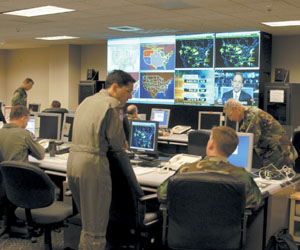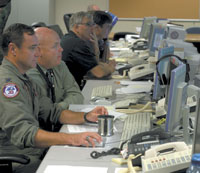Coalition Interoperability Strategy Comes Home
 |
The U.S. Northern Command (NORTHCOM), the combatant command responsible for homeland defense, has established a situational awareness room that is used in operations as well as exercises. |
After years of searching for interoperability solutions for the multinational environment, this year the U.S. military will focus on how to ensure connectivity at home for coalitions comprising federal, state and local agencies. Using a familiar venue, the U.S. Defense Department will not only examine technical issues but also verify concepts of operations, concepts of employment and tactics, techniques and procedures. Event participants will be geographically dispersed and operationally diverse as they explore how network-centricity can support homeland security and defense.
Dealing with a single disaster—whether natural or manmade—involves personnel with various types of expertise working in numerous government agencies managing the intricacies of rescue, recovery and investigation. Sharing information and coordinating a multitude of agencies will be crucial but entails planning. Tackling this challenge requires a setting that blends the features of experiments, exercises and mission rehearsals, and the Joint Warrior Interoperability Demonstration (JWID) fits the bill, according to military leaders.
U.S. Northern Command (NORTHCOM), Peterson Air Force Base, Colorado Springs, Colorado, will host JWID 2004. For the second consecutive year, the Defense Information Systems Agency (DISA), Arlington, Virginia, will be the lead agency of the event, which is sponsored by the chairman of the Joint Chiefs of Staff and set to take place June 1 through 24.
With a theme of “Forging New Coalitions,” this year’s event will focus on U.S. government interagency interaction. All nine of the unified commands will participate in the demonstration, and coalitions will involve new partners such as the U.S. Department of Homeland Security, the U.S. Coast Guard and the National Guard Bureau. In addition to the Canadian Defence Forces, a traditional JWID participant, Canada’s Office of Critical Infrastructure Protection and Emergency Preparedness will participate this year. JWID organizers continue to seek opportunities to improve information sharing with federal, state, local and nongovernmental agencies as well as first responders.
Maj. Gen. Dale W. Meyerrose, USAF, director, command control systems, Headquarters North American Aerospace Defense Command, says that the command will examine a range of technologies. The general, who is also the director of architectures and integration, NORTHCOM Headquarters, adds that the solutions should support the ‘need to share’ culture the command is developing and enhance its situational awareness, collaboration, alerting mechanisms, decision making, and command and control responsibilities.
“We are not only working on the technological solutions but also emphasizing the accompanying concept of operations and tactics, techniques and procedures to make potential solutions immediately available and ready to implement post-JWID. We selected candidate JWID tools that focus on improving horizontal information sharing in the anti-terrorism and force protection arena. Additionally, we are hoping to find potential enhancements for the homeland security and homeland defense common operational pictures that we share among our many partners,” Gen. Meyerrose says.
JWID 04 will concentrate on what the general calls “system agnostic” and open trusted information exchange environments. Network-centric concepts will be explored with distinctions made between supported and supporting functions, sharing intelligence and information, and data mining and fusion.
“Rather than using the traditional coalition task force as the centerpiece, JWID 04 scenarios will target information sharing and collaboration on a broader and more horizontal scale,” Gen. Meyerrose says. “However, make no mistake; most of the goals of this JWID will be the same as its predecessors’ because making technology work is more about culture and process than passing ‘ones and zeros.’”
The general explains that Defense Department experiments, rehearsals and exercises are each designed to attain different goals. Experiments are about figuring out what to do; rehearsals allow troops to prepare for operations; and exercises enable the military to assess training and capabilities, he relates. JWID is ideal for both examining technical interoperability and verifying concepts because it is a hybrid of all three, so it provides a superb opportunity for blending the why and the how, he asserts.
Unlike in previous JWIDs, which involved a single joint task force with a specific mission, this year’s event will feature multiple scenarios. The types of emergencies that will compose the scenarios include natural disasters as well as incidents of biological or chemical agent dispersal. Scenario designs are being drawn from what the command perceives as central elements of the global war on terrorism. Some will start overseas, but the effects will spread to the United States. Multiple scenarios will be played out in various locations simultaneously with different combinations of people responsible for sorting out the response.
The focus will be on connecting first responders at the local, state and federal levels with operational watch centers. Assessments will take place at many levels, from individual nodes to the overall operating environment. Three computer network defense trials also are scheduled for the event, and one aspect of JWID will be command and control of network operations.
“This approach does a couple of things. First of all, it makes sure that we can handle more than one incident, and that’s very, very important. If you think back to 9/11, there were three incidents and, one could hypothesize, maybe more incidents in the offing that never took place. We feel that the asymmetric threat of multiple smaller incidents is one that we must train and prepare for, so that provides the logical characterization of a good JWID for homeland security and homeland defense,” Gen. Meyerrose says.
 |
Controllers in NORTHCOM's situational awareness center monitor the multiple, simultaneous homeland defense and federal relief events of the DETERMINED PROMISE 2003 exercies. Since its inception on October 1, 2002, NORTHCOM has participated in 50 exercieses. As the host for the Joint Warrior Interoperability Demonstration this year, NORTHCOM will focus on finding solutions to assist with interagency information sharing. |
Homeland defense and homeland security missions pose challenges similar to those that multinational military coalitions must address during operations: security, situational awareness, information sharing and logistics. Interoperability between communications systems is essential; the only difference is the players. Legally, certain agencies are designated to lead in specific types or aspects of events. Because responsibilities may cross lines, the command and control element in these operations is very important. JWID will help the Defense Department determine what type of support it can provide to other agencies and vice versa, the general explains.
As in previous JWIDs, industry will team with the Defense Department or other government agency sponsors to provide coalition interoperability trials for evaluation. Planners have identified eight objectives that are the framework for organizations and companies that propose technologies to be part of the event.
Multilevel secure information sharing across information domains is one objective. Each government agency that supports homeland security has network architectures, but the need for information sharing requires that these domains can communicate with each other in a secure manner. Solutions are being sought that facilitate flexible, fast and protected information sharing.
The requirement for situational awareness in homeland security efforts equals that of commanders on the battlefield. Technologies that deliver information to military, government or civilian personnel during a crisis must expand or contract to support the needs of individual users. To accomplish this task, NORTHCOM must have the ability to automatically input and receive data on the Global Command and Control System from all homeland security and Defense Department agencies. Consequently, JWID organizers are interested in technology solutions that address system integration and data conversion issues.
The third objective for JWID 2004 is to identify object-oriented solutions to encrypt data to replace or improve current guarding technologies so that agencies can improve information sharing. While a long-term goal is to adopt common database structures and schemas, JWID planners are now interested in short-term solutions that permit translation between existing databases.
Intelligence, surveillance and reconnaissance (ISR) information is as important to homeland security as it is in the battlespace. The growing need to share and disseminate ISR data to several information domains operating at various security levels requires tools that permit enhanced sharing of these products within and across coalition and interagency information domains. JWID planners are interested in seeing demonstrations of technologies that can accomplish this task.
Because first responders are likely to use a variety of wireless devices, the fifth objective for JWID 2004 is to examine technologies that provide security for information sent between fixed-location and mobile users. Technologies are being sought for secure information, voice, data and video transmissions.
The sixth objective addresses another aspect of securing networks. NORTHCOM is interested in capabilities that can monitor networks and defend against threats to multiple information systems. In addition, interagency activity requires solutions that provide multiple security levels.
Coordinating the efforts of various agencies will require logistics approaches that include input from multiple information sources. JWID 2004 planners want to examine capabilities that allow total visibility of friendly forces as well as of assets and supplies. This information must be presented in one format and across multiple domains.
Lastly, although language translation capabilities are a more apparent requirement of multinational operations, JWID 2004 planners have identified this as a priority as well. Other nations may assist the United States in homeland security and defense operations, so they are seeking tools that enable the translation of documents, displays and written or audio exchanges between agency personnel.
From the beginning, JWID was designed specifically to address emerging missions, new interoperability and integration challenges, and critical warfighter concepts of operations and employment. That is one reason Gen. Meyerrose believes NORTHCOM is an ideal host site for this year’s demonstration. “JWID provides the opportunity to use and validate candidate solutions to enhance NORTHCOM’s capabilities and that of our partners to succeed at homeland security and homeland defense missions. … We see JWID 04 as tailor-made to develop further the ‘need to share’ construct in providing flexible, tested solutions for us to evaluate in the context of enhancing homeland security and homeland defense mission effectiveness,” he says.
Although the event centers on U.S. activity, the general points out that all nations share the responsibility of combating terrorism. “The last couple of years demonstrated that threats, actions and reactions are global in nature and are interdependent. It is our goal to take the fight to those who support terrorism rather than waiting for them to attack us in NORTHCOM’s area of responsibility and our homeland. To the greatest degree possible, we want to make as many of these confrontations as possible an ‘away game’ rather than a ‘home game,’” he says.
To accomplish this task effectively, the command must interoperate with other regional combatant commands and their coalitions, Gen. Meyerrose states. “For us, the term coalition is multifaceted as it applies to us in the traditional sense for fighting the global war on terrorism, but it can also be viewed as synonymous with interagency operations. It’s our responsibility to use the JWID venue to improve interoperability, whether through enabling technologies or overcoming cultural and procedural barriers,” the general maintains.
Coalition operations require horizontal information sharing, a new concept that resembles information sharing in other organizations but is unique in some respects for the military. The nature of NORTHCOM’s responsibilities gave birth to an information exchange culture. Gen. Meyerrose says that the command leadership believes that, with the right amount of effort and right focus within JWID, the command will improve its own understanding of what that means and increase understanding of its meaning throughout the Defense Department.




Comments